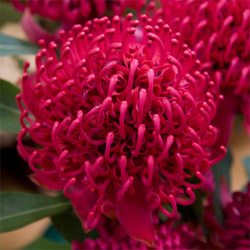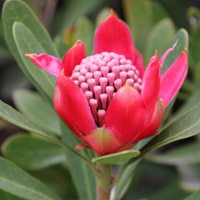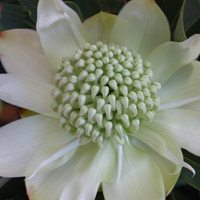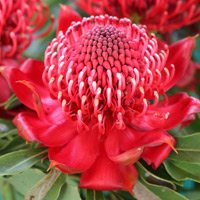
Waratah Plants (Telopea)
Waratahs are an iconic and revered Australian native plant with stunning red blooms, rich cultural significance and ecological importance. These native flowers belong to the Telopea genus with Telopea speciosissima, also known as the New South Wales Waratah, the most widely grown.
Though the New South Wales Waratah takes centre stage, other equally attractive species like Telopea truncata and Telopea oreades from Tasmania and Victoria, and Telopea aspera from New South Wales grace gardens as well.
The most distinctive feature of the Waratah is its large and striking flower head, which can measure up to 15cm in diameter. The flowers are also known for their longevity, as they can remain in bloom for weeks. These plants attract birds and can serve as impressive specimen plants or as bushy shrubs at the back of garden borders. Waratahs have adapted to Australia’s fire-prone landscapes, as woody swellings (lignotubers) at the base of the plant help them survive fires by allowing for regrowth after the flames have passed.
Telopea speciosissima proudly holds the title of New South Wales’ floral emblem, signifying its cultural importance. Gardeners are drawn to its brilliant red blooms in spring, and its flowers make exquisite cut arrangements. These evergreen shrubs or small trees are native to southeastern Australia and especially prominent in New South Wales.
Waratahs are found growing along the east coast of Australia from Northern New South Wales to Tasmania. Waratah plants are available for sale from most good specialist Australian plant nurseries, usually in late winter to spring when they are in flower.
How to Grow Waratah Plants
Waratahs will flower every year once established, for 4 to 8 weeks during spring. In warmer regions, they will flower in early spring, while in cooler climates, they will flower a bit later. Although Waratahs flower in spring, they are best planted in autumn if you wish to give them time to settle in and make the most of their initial flowering.
- Sun and Shade: All Waratahs perform best in full sun, although light, dappled shade is better in warmer climates. Deep shade will cause a lack of flowers and more spindly growth.
- Protection from strong winds: Is recommended. A sheltered position will not only prevent wind damage but also prevent the flowers from wind burn damage on hot days.
- Watering: Once established, watering will depend entirely on the soil and the position. In good soil and some afternoon shade in the heat of summer, they require little or no extra water. In poorer soils, hotter climates, or exposed positions, they will require regular watering through summer. Water thoroughly, allowing the soil to partially dry before watering again.
- Fertilising: Apply native plant fertiliser immediately after flowering, watering in well. Opt for a slow-release, low-phosphorus fertilizer for best results and apply a thick layer of mulch.
Pruning Waratah
Regular pruning, best carried out directly after flowering in early summer, helps maintain a bushy and healthy Waratah. With younger plants, simply picking the flowers will be enough. However, as they mature over the years, you can trim them back by about one-third after they have finished flowering.
Older plants (8-10 years) can develop lots of hardwood. Waratahs can be given a ‘new lease on life’ by heavy pruning, cutting right back to the crown. These plants will re-shoot as this mimics the effect of bushfires to some extent, which encourages the natural rejuvenation of many Australian plants.
Waratah flowers are ideal for cut arrangements and last quite well.
Waratah Varieties
Waratahs showcase a variety of species and cultivars, including:
- Telopea aspera
- T. mongaensis – (Braidwood Waratah) – NSW
- T. oreades – (Gippsland Waratah) – Vic
- T. speciosissima – (NSW Waratah)
- T. truncata – (Tasmanian Waratah)
- Alloxylon pinnatum – (Dorrigo Waratah)
- Alloxylon flammeum – (Queensland Tree Waratah)
In addition to the red varieties, there are the White Waratah (Telopea speciosissima x oreades) and a yellow flowering cultivar (Telopea speciosissima x truncata x oreades), with T. speciosissima ‘Wirrimbirra White’ being among the first named white-flowering cultivars.
Commercially available varieties
- Braidwood Brilliant
- Tomoko – Late flowering with red flowers
- Shady Lady® ‘Red’ – White flowers in spring. Also available in red, pink and yellow.
- Linda – Large red flowers in spring
- Sarah Red – Smaller flowers in spring
Propagation
Although Waratahs are easy to grow and fast-growing once established, it will take 4 – 6 years for the plant to flower from a seedling. Waratahs can be propagated from cuttings or grown from seeds.
Waratah seeds typically take about a month to germinate, but growing them from seeds can be difficult because young seedlings are prone to fungal diseases. The solution is to ensure that the drainage is good. They can be sown when fresh into sharp sand and kept moist, not wet, until they germinate.
From cuttings, plants will flower in around two years.
Care
Caring for Waratahs is relatively straightforward. Whether grown in the garden or in pots, they thrive in sunny locations with well-draining soil. Giving them enough space to grow encourages flowering and good airflow.
Common problems with Waratahs are usually related to overwatering or poor drainage, leading to root diseases like Phytophthora, which can kill plants quickly. Scale insects and bud borers can also pose problems.
Waratahs are available for sale from the following nurseries
Available for sale from the following nurseries
470 Monbulk-Silvan Road Monbulk VIC 3793
"Guaranteed mail order flowering bulbs, perennials, roses, trees, landscaping plants, garden accessories and community fundraising Austra lia-wide."
www.gardenexpress.com.au
You may also be interested in




